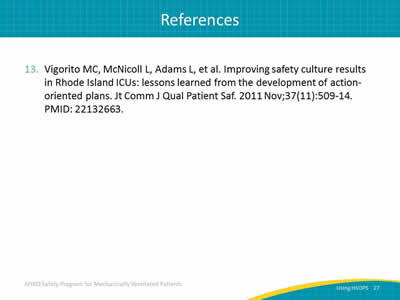Assess Patient Safety Culture Using the Hospital Survey on Patient Safety: Facilitator Guide
AHRQ Safety Program for Mechanically Ventilated Patients
Slide 1: Assess Patient Safety Culture Using the Hospital Survey on Patient Safety
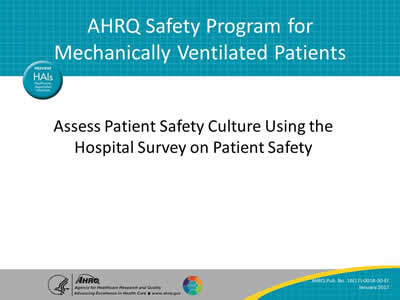
Say:
In this module, we will introduce the Hospital Survey on Patient Safety, or HSOPS, and review why it is important, as well as how you can use this tool to better assess the patient safety culture in your organization.
Slide 2: Learning Objectives
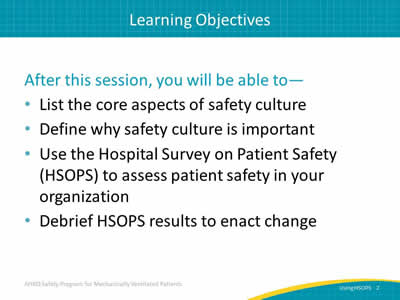
Say:
After this session, you will be able to list the core aspects of safety culture, define why safety culture is important, use the HSOPS to assess patient safety in your organization, and debrief HSOPS results to enact change.
Slide 3: What Is Safety Culture?
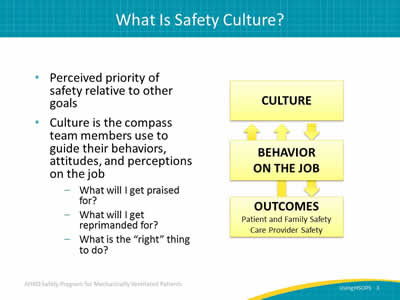
Ask:
What is safety culture?
Say:
Safety culture is the perceived priority of safety relative to other goals. From a sociological standpoint, a culture involves everything that happens around that given environment. Our culture shapes our behaviors, our attitudes, and our perceptions. In our work environment setting, we participate in a hospital culture and in a health care system culture. We think about manifesting culture when we ask ourselves, "What will I get praised for? What will I get reprimanded for? What is the right thing to do?"
In a way, this culture helps us understand what is good, bad, right, and wrong, so that we can also understand the appropriate way to behave. Culture shapes behavior on the job but it also improves outcomes. Not only does it improve patient and family safety, it also improves the safety of the care provider. Safety culture does not exist in a vacuum; it is being shaped while also shaping other factors.
Slide 4: Core Aspects of Safety Culture
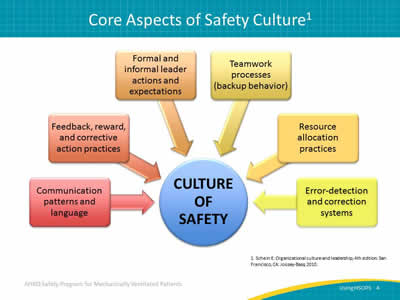
Say:
The culture of safety has six main components. Communication patterns and language are an important part of the culture of safety, as how you communicate effectively with each other is crucial. Secondly, you can see feedback, potential incentives, and corrective action practices. We use these to create and improve nonpunitive culture. The third core aspect includes the formal and informal actions and expectations of your leadership, as management is an important part of this culture of safety. The next aspect is the teamwork process, whether it is handoff transitions or how your teams work together in a setting. Resource allocation practices are also a core factor in the culture of safety. These practices ensure adequate staffing, materials, and support. Finally, error-detection and correction systems are used to report medical errors and any other errors that occur in the system.
Slide 5: Model for Improving Care
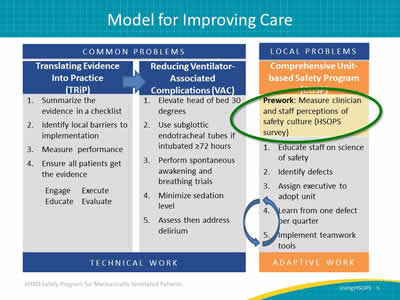
Ask:
Where is the culture of safety and HSOPS survey actually located within a CUSP intervention?
Say:
There are two parts to the Comprehensive Unit-based Safety Program, or CUSP: the technical work and the adaptive work. The technical work will instruct you on what to do while the adaptive work requires you to adapt to the needs of your work environment. The HSOPS survey will help to inform you of the current status of your safety culture so you can address the adaptive work.
Ask:
What might you discover?
Say:
You may discover that hospital management is not prioritizing safety culture, and therefore you might want to speak with your management. Alternatively, you might find that handoff transitions are weak, which you should address in order to improve your safety culture. Everyone who implements the survey will find unique data that can help improve their own work setting. Safety culture is considered adaptive work because you have to adapt the work environment to your own hospital and unit's needs.
Slide 6: Safety Culture Is Related to Outcomes
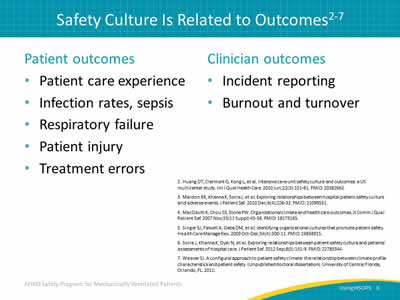
Say:
Safety culture has been shown to affect both patient and clinician outcomes. In terms of patient care experience, hospitals with a better safety culture tend to have lower rates of infection, sepsis, postoperative hemorrhage, respiratory failure, accidental puncture or laceration, and fewer treatment error cases.
The better a hospital’s safety culture, the better the incident reports tend to be. Achieving a positive safety culture creates a general willingness in clinicians to learn from all errors that have been made.
Safety culture also affects burnout and turnover rates. For instance, if safety culture is weak in a hospital or unit setting, the burnout rate among clinicians is most likely very high, causing turnover rate to also be very high.
Safety culture not only influences the effectiveness of other safety and quality interventions, but it can also change through intervention. We have the ability to shape it, influence it, and change it. Safety culture is not static; so, you have the potential to transform it.
Slide 7: Why Safety Culture Matters
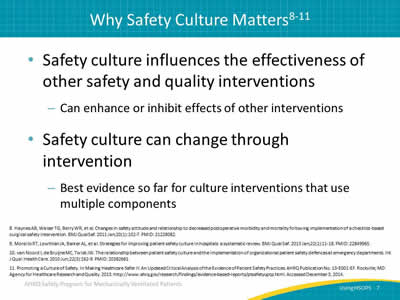
Ask:
Why does safety culture matter?
Say:
Safety culture matters because it influences the effectiveness of other safety and quality interventions by either enhancing or inhibiting them. Safety culture can also change through intervention. The best evidence for improving safety culture comes from interventions that use multiple components.
Slide 8: Measuring Safety Culture
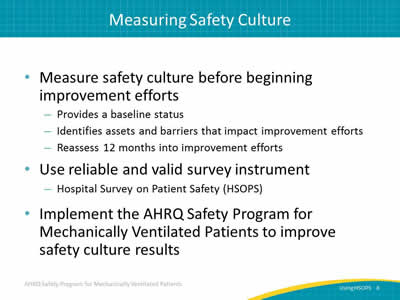
Ask:
How is safety culture actually measured?
Say:
HSOPS and a Safety Attitudes Questionnaire can be used to measure safety culture. These surveys are only effective in measuring safety culture by the data that is collected in the process. A baseline status, for instance, is established by the data that you collect from HSOPS before you start the intervention. You should also collect followup data, approximately a year to 18 months after you started collecting the baseline data, to determine any changes. This comparison of data will provide you with an analysis determining if the intervention influenced any changes. Implementing the Agency for Healthcare Research and Quality, or AHRQ, Safety Program for Mechanically Ventilated Patients is just one way to see an improvement in your team’s safety culture reflected in your HSOPS results.
Slide 9: What Is HSOPS?
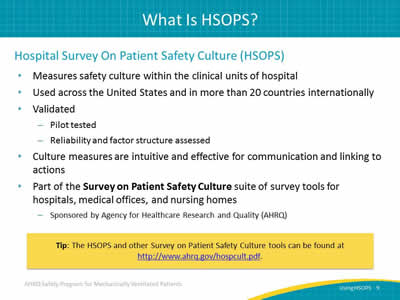
Ask:
What does HSOPS specifically entail?
Say:
HSOPS was created by AHRQ. It has been used to measure safety culture within the clinical units of hospitals. It is crucial to note that safety culture is unique to these clinical units. While it is relatively easy to conduct a broad measurement of safety culture in a hospital, it is more informative to assess the safety culture within a unit. Within a hospital, every unit serves a specific function and experiences unique challenges and victories. It is important to capture these unit-specific details in order to best understand the safety culture in your own unit.
HSOPS is used across the United States and in more than 20 countries internationally. It has been validated through pilot tests and assessments of its reliability and factor structure.
Culture measures are intuitive and effective for communication and linking to actions.
There is an online survey tool that provides the HSOPS. This convenient tool only takes about 10 to 15 minutes to complete. The HSOPS tool can also be used to examine details of your safety culture and that of other units and hospitals. By providing details in the form of diagrams and charts, these reports allow you to see how your units and hospitals compare with the national average of other units and hospitals which have completed this questionnaire.
Slide 10: HSOPS Dimensions
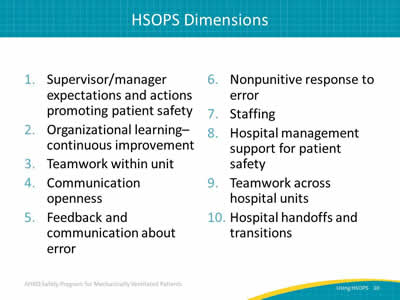
Say:
There are 10 HSOPS dimensions, each with 3 or 4 corresponding questions. As discussed earlier, safety culture is a constructed idea, ultimately composed of these 10 dimensions. A supervisor or manager’s expectations and actions toward promoting patient safety make up one of the HSOPS dimensions, specifically revealing the importance of management in safety culture. Organizational learning, continuous improvement, teamwork within the unit, and communication openness are other dimensions. Having open communication involves having a discussion and receiving feedback about error, nonpunitive response to error, staffing, hospital management support for patient safety, and teamwork across hospital units. Teamwork within and across hospital units eventually yields hospital handoffs and transitions, building upon a communal safety culture.
Slide 11: HSOPS Sample Questions
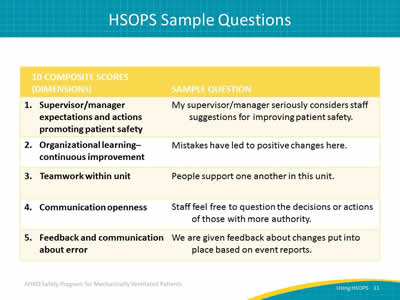
Say:
The first dimension—supervisor or manager expectations and actions in promoting patient safety—may have a sample question such as, "My supervisor/manager seriously considers staff suggestions for improving patient safety. How do you feel about this statement?" Your study project participants would then choose among these options: "agree, strongly agree, neutral, disagree, and strongly disagree." The third dimension—teamwork within the unit—may have a sample question such as, "People support one another in this unit," to which participants would choose among the same options as the previous question. This is how your study project participants will fill out the survey.
Slide 12: HSOPS Sample Questions
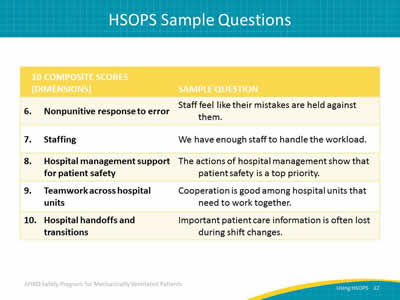
Say:
This slide presents a few more examples of potential sample questions that could correspond to several other dimensions. For instance, the seventh dimension—staffing—may have a sample question such as, "We have enough staff to handle the workload." Your study project participants will then respond with some level of agreement, disagreement, or neutrality concerning the statement.
Slide 13: HSOPS Sample Questions
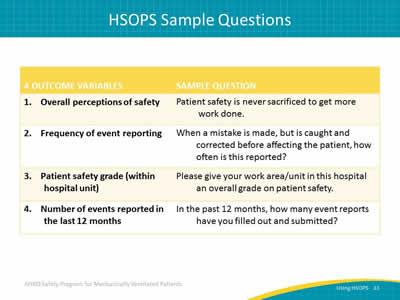
Say:
HSOPS also produces four outcome variables. The first outcome variable involves how your study project participants perceive safety within your unit. A potential sample question may be, "Patient safety is never sacrificed to get more work done. How do you feel about this statement?" Responses are then reported. The second outcome variable is frequency of event reporting. Participants may be asked, "How often are near misses reported?" Patient safety grade, which grades the perception of safety within your unit, and the number of events reported by study project participants within the last 12 months, are the third and fourth outcome variables, respectively.
Slide 14: HSOPS Scoring
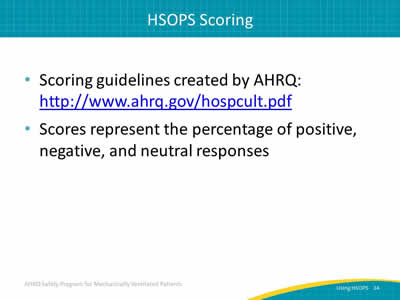
Say:
After your respondents have filled out the survey, the results are graded by AHRQ’s scoring guidelines. Some items are worded positively, and some are worded negatively, and the scoring guidelines show you how to account for the responses to both types of questions. Follow the guidelines for scoring and for calculating percentages of positive, negative, and neutral responses. These guidelines can be found on the AHRQ Web site.
Slide 15: Effective HSOPS Surveys…
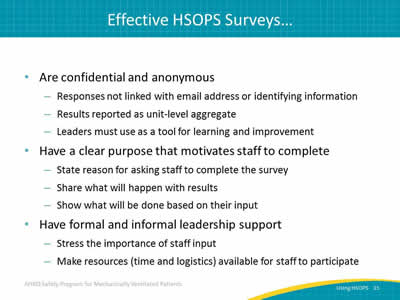
Ask:
How can you determine the effectiveness of HSOPS surveys?
Say:
If you want to be certain that staff members working on these safety efforts in this program take this survey, it is important that they recognize its importance.
As a preliminary measure, please emphasize that responses to this survey, especially within the section discussing management, are both confidential and anonymous. People tend to feel uncomfortable when rating management, so it is vital that you emphasize that this data will produce no consequences if results are not what the management is specifically looking for.
You must also have a clear purpose that motivates staff to complete the survey. A relatively common question among peers is, "Why take this survey if it is not going to change anything?" In order to make a change through this survey, please emphasize that improvements to safety culture within your unit require the type of communication that can be established through this survey by the responses your staff provides.
Hospitals that have succeeded in collecting HSOPS surveys with a response rate above 70 percent tend to have some form of either formal or informal leadership support. This can include a chief medical officer who sends emails on behalf of the survey coordinators in an effort to improve response rate. Management support is crucial as it not only indicates a desire to see changes, but it represents the willingness of the management to listen to concerns, to take these concerns seriously, and to implement action toward improving safety culture.
Slide 16: Response Rate Matters
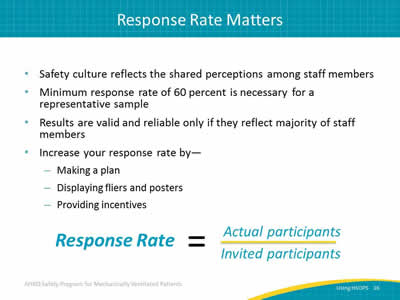
Say:
Safety culture reflects the shared perceptions among staff members. Results of staff perception are only valid and reliable if they reflect a majority of these staff members. As a result, a true representative sample of staff perception requires a minimum response rate of 60 percent.
Ask:
How can you increase your HSOPS response rate?
Say:
You must first set a goal. If you set a high goal, around 70 or 80 percent, it is easier to reach the required response rate of 60 percent. If your goal is set to this bare minimum of 60 percent, your response rate is more likely to result as 50 percent or lower. Therefore, it is important to set a high goal, even up to 90 percent. While few hospitals manage to achieve a 90 percent response rate, many hospitals experience an 80 percent response rate.
In order to obtain such a strong rate, effective management support as well as flier and poster displays are necessary. If your project participants keep noticing these fliers and posters on the notice board, informing them where they can find an HSOPS survey and why filling out the survey is important, it can motivate them to participate in that survey. Even assigning a notice board specifically for HSOPS safety culture is an effective way to improve response rate. Provide incentives if possible, such as a raffle or a competition between units or provider groups that results in some sort of reward. Creativity is strongly encouraged towards improving response rate.
Slide 17: Successful Prenotification
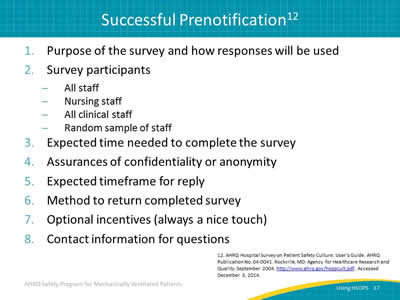
Say:
Prenotifying staff about this survey can help to increase your response rate. On this slide, you can see eight tips for a successful prenotification strategy
The first tip is to clearly state the purpose of the survey in combination with how its responses will be used.
Next is a brief list of suggestions on who to include as survey participants. It is important to identify survey participants as early as possible, typically based on their familiarity with the safety culture within the unit. Two to three months within a unit can indicate a sufficient understanding of safety culture while one or two weeks will not. Recommended survey participants include all staff members, whether they are physicians, nurses, or environmental workers. All of those people can participate in HSOPS because they are all part of that unit. You should allow everybody in your unit to have a voice and participate in this HSOPS survey.
You should provide participants with the expected time it will take to complete the survey as well as assure them that all responses are confidential and anonymous. It is also helpful and beneficial to also provide them with a timeline that includes when the survey can be completed as well as the deadline for submitting responses. This way, survey participants recognize the timeliness of completing and submitting the survey. Additional items to consider including are indicating the methods for submitting the completed survey, list optional incentives that may motivate staff to participate, and contact information for any questions that they might have about the process.
Slide 18: Additional Tips for Effective Surveys
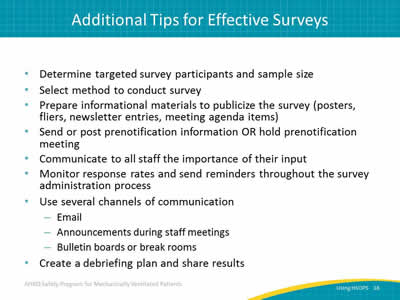
Say:
In addition to the eight prenotification tips, you should consistently communicate to all staff the importance of their input, monitor response rates, send reminders throughout the survey administration process, use several channels of communication such as email, and make announcements during staff meetings or post on bulletin boards and in break rooms. You should also create a debriefing plan to share results.
Slide 19: Turning HSOPS Data into Action
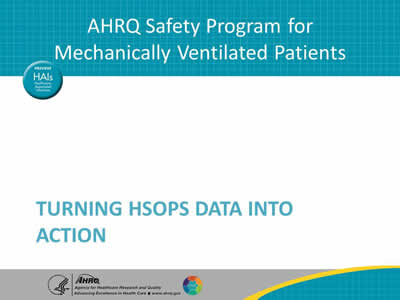
Say:
Now we will discuss how we can implement the data collected from HSOPS into practices that will improve safety culture.
Slide 20: What Is Debriefing?
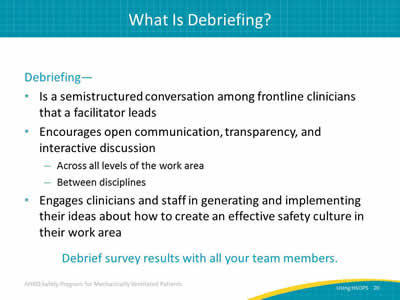
Ask:
What is debriefing?
Say:
Debriefing is a semistructured conversation among frontline clinicians led by a facilitator. The purpose of this conversation is to engage clinicians and other staff members across all levels of the work area and between disciplines in open communication about the resulting data without any judgment. One study shows that successful debriefing can produce a 10.2 percent reduction in infection rates, an 8 percent improvement when compared with hospitals with safety culture that did not engage in debriefing. As a result, debriefing can make a significant difference in infection rates.
Slide 21: Debriefing—Making HSOPS Data Meaningful
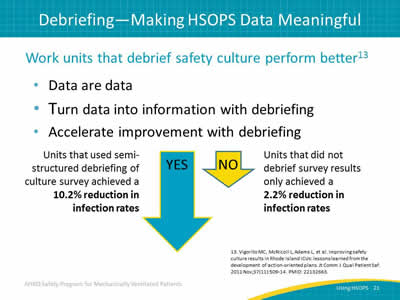
Say:
Evidence shows that work units that debrief safety culture tend to perform better than those that do not. Data are only numbers and figures until debriefing turns it into comprehensive information to accelerate safety culture improvement.
Slide 22: Benefits of HSOPS Data
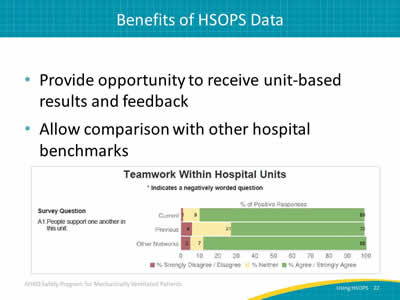
Say:
HSOPS data provide the opportunity to receive unit-based results and feedback. The results individual units receive can then be shared and compared with those of other hospitals, establishing a communal awareness toward improving safety culture.
Slide 23: Questions?

Ask:
Are there any questions?
Slide 24: References
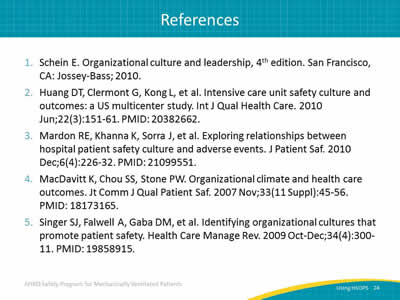
Slide 25: References
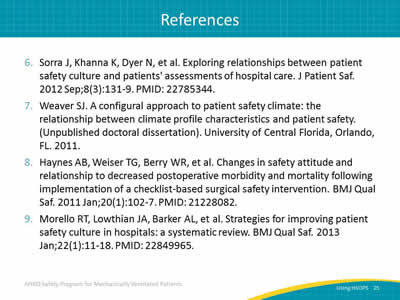
Slide 26: References
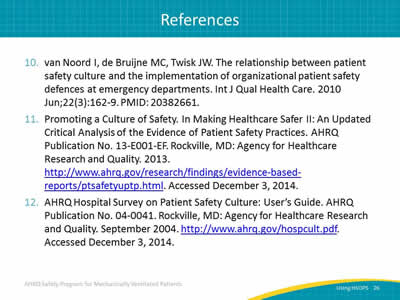
Slide 27: References
